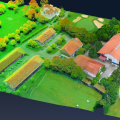
Photo-realistic 3D mapping and digital reconstruction of an ancient underwater city in Greece have earned a team from the University of Sydney's Faculty of Engineering and Information Technologies top honours in Canon Australia's Extreme Imaging competition.
Ariell Friedman, an engineering PhD student co-supervised by Professor Stefan Williams and Dr Oscar Pizarro at the University's Australian Centre for Field Robotics, won the prize for his project titled 'Diver-based stereo 3D documentation of excavations in Pavlopetri'.
The marine robotics team worked on location at Pavlopetri, the oldest known submerged city, which lies off the coast of Greece's southern Laconia region.
Up to four metres of water covers artefacts and structures dating back 5,000 years. Ariell's work not only involved operating the diver rig, but also modifying and improving the diver camera system and the development of software to allow the rapid production of maps by automating the data processing pipeline.
The Extreme Imaging competition is run by Canon Australia and CiSRA, Canon Inc.'s Australian research centre, and aims to promote and acknowledge local research at the intersection of imaging and technology.
"The competition recognises local advances in imaging science and recognises projects where students create equipment that can produce images beyond the boundaries of creative photography and video."
"The competition is open to students from any department – medicine, mechatronics, physics, engineering, computer science and the visual arts across Australia," said Stephen Hardy, Senior General Manager, CiSRA.
The runner up in the competition was Ben Norton and Supervisor David Kielpinski from Griffith University’s Centre for Quantum Dynamics for developing techniques to take some of the highest resolution images of atoms ever made, including the first ever image of the shadow of a single atom.
Imaging single atoms is important for understanding physics, the new field of quantum computing and may also have applications for ultra-high resolution imaging of biological cells.







